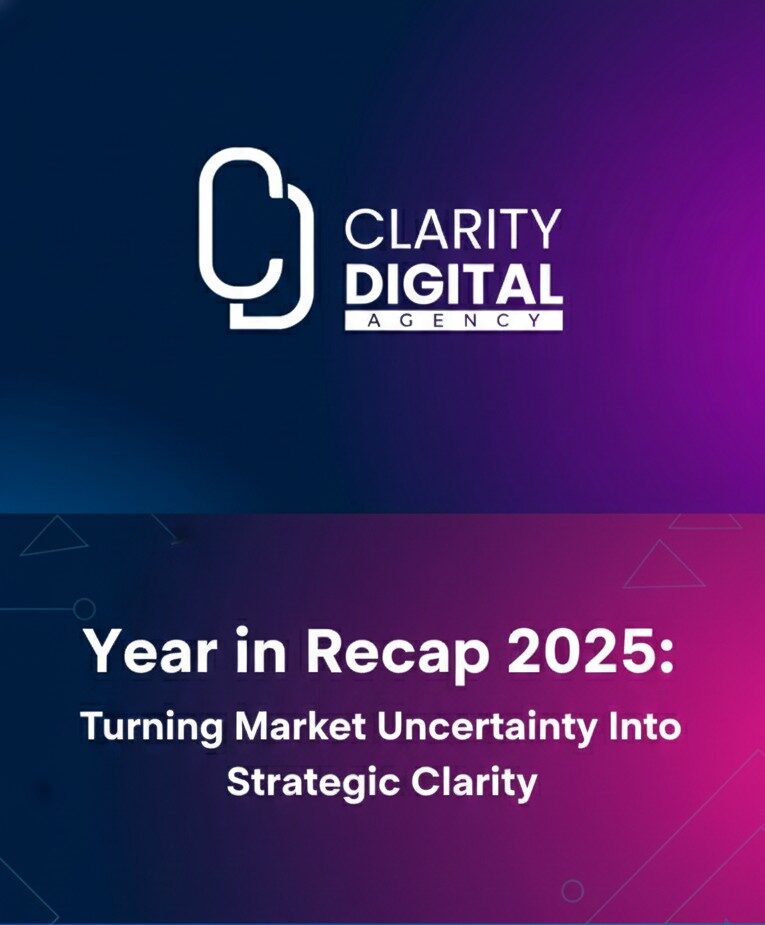An conversion with Sales Executive, Chris Marocchi, MBA.
In this episode of Clarity Digital Pod, I sit down with sales executive and marketing veteran Chris Marocchi, MBA to unpack one of the most common and costly challenges in the B2B world: the disconnect between sales and marketing. Chris brings a unique perspective to the discussion, having worked extensively in both disciplines and across agency, corporate, and entrepreneurial environments.
With experience ranging from Madison Avenue advertising to running his own marketing agency, and later leading sales teams in the software and services sectors, Chris has seen how alignment between sales and marketing can make or break a business. In our conversation, we covered lead generation, sales enablement, pipeline building, networking, and why outsourcing marketing can often deliver better ROI than building large in-house teams.
This post will walk through the most important takeaways from our discussion, with practical insights for B2B leaders who want to turn their sales and marketing teams into true growth partners. Let’s get into it:
From Madison Avenue to B2B Sales Leadership
Chris’s career began on Madison Avenue, the epicenter of advertising in New York City. With a degree in advertising and an MBA in marketing, he started in a world reminiscent of Mad Men, but without adopting its infamous lifestyle. Instead, he focused on mastering brand strategy and campaign execution, working with Fortune 500 clients and major agencies.
Over time, Chris moved between agency and client-side roles, gaining experience in industries such as food and beverage, manufacturing, and industrial products. In the early 2010s, he launched his own marketing agency, which is where our paths first crossed. I handled SEO and search marketing for one of his clients, and that partnership showed both of us the value of transparency, education, and long-term thinking in client work.
By 2015, Chris transitioned to sales leadership, where he has spent the past decade managing B2B sales teams, particularly in software and professional services. That mix of marketing and sales experience gives him rare insight into how both functions should work together.
Why Sales and Marketing Are Often Misaligned
Many B2B companies struggle with siloed sales and marketing operations. Marketing teams run campaigns, generate clicks, and track awareness metrics, while sales teams are focused on hitting quotas and closing deals. If those two areas are not coordinated, companies burn through budgets without seeing proportional revenue growth.
Chris explained that part of the problem lies in how companies define a qualified lead. Too often, marketing uses lead scoring from platforms like HubSpot or Marketo to flag someone as “marketing qualified” based on activity like opening emails or downloading a resource. But without verifying buying intent, these leads are not truly ready for sales. The result is frustration for sales teams, who waste time on low-quality prospects, and frustration for marketing, who feel their work is undervalued.
Defining a Qualified Lead in B2B
One of the most actionable points from our discussion is that a qualified lead is more than a score. Chris recommends a layered process:
- Marketing generates leads and tracks engagement
- A BDR (Business Development Representative) follows up directly to assess intent
- Only then does the lead move to sales for in-depth conversations and closing
This extra qualification step ensures that sales is spending time only on prospects with genuine interest and buying potential. Many companies skip this stage because they lack a dedicated BDR function, but without it, sales and marketing alignment will always suffer.
Building Pipeline in Challenging Markets
Chris pointed out that 2024 has been a challenging year for B2B sales in certain sectors. Economic uncertainty, tariffs, and high interest rates have caused many companies to delay major purchasing decisions. Seasonal factors, like summer vacations for executives, also slow down deal flow.
His solution is to focus on long-term pipeline development through two main strategies:
- Networking: Building relationships in targeted professional groups, positioning himself as a trusted advisor rather than a pushy salesperson.
- Consistent Communication: Using webinars, email campaigns, and value-driven content to keep prospects engaged until they are ready to buy.
This approach keeps the pipeline active, even if sales cycles stretch out.
Marketing Effectively Without Overspending
One myth we tackled is that impactful marketing requires massive budgets. Chris stressed that you can achieve strong results with modest investments if you use the right strategies and execute them well.
The bigger challenge for many companies, especially smaller B2B firms, is execution. Assigning all marketing responsibilities to one in-house marketer often leads to limited results. That person may be great at certain areas but lack expertise in others, such as paid media, analytics, or automation.
This is where outsourcing marketing pays off. By hiring a specialized agency, companies can access subject matter experts in every discipline without the overhead of multiple full-time salaries. Even enterprise-level organizations outsource for specific needs. In fact, our agency has handled SEO and analytics projects for Google itself when their internal teams were at capacity.
From Clicks to Conversions
Chris emphasized that traffic is not the goal. Conversions are. A campaign with high click-through rates but no qualified leads is a wasted effort.
To turn clicks into conversions, marketing must focus on:
- Relevant, audience-focused content
- Clear and compelling calls to action
- Landing pages optimized for lead capture
- Follow-up systems that nurture interest into intent
Sales and marketing must review these metrics together, focusing not only on lead volume but on lead quality and conversion rates.
The Role of Sales Enablement
Sales enablement bridges the gap between marketing and sales by providing sales teams with the resources, tools, and qualified leads they need to close deals effectively. Chris believes this is one of the most underdeveloped areas in many B2B companies.
Egos often get in the way. Marketing resists feedback from sales, and sales assumes marketing does not understand the front-line reality. But alignment is not optional if you want sustained revenue growth. Regular communication, shared goals, and mutual respect are essential.
Networking as a Growth Engine
Beyond digital strategies, Chris is a strong advocate for in-person networking. Living in Orange County, he calls it one of the most active networking hubs in the country. He participates in organizations like Provisors and targeted industry roundtables, where the focus is on building trust and generating referrals.
His advice for effective networking:
- Be consistent in attendance
- Be clear in your messaging and who you can help
- Follow up with high-potential referral partners regularly
Networking is not about collecting business cards, it is about building relationships that generate opportunities over time.
Closing Thoughts
Our conversation with Chris Marocchi, MBA, highlighted that aligning sales and marketing is not just a best practice, it is a necessity for B2B growth. Without alignment, you risk losing opportunities, wasting resources, and creating friction between two functions that should be working in lockstep.
The key takeaways:
- Define qualification clearly and include a human verification step before leads reach sales
- Build pipeline consistently, even when market conditions slow decisions
- Use modest but smart marketing investments and consider outsourcing for better ROI
- Focus on conversions, not just clicks
- Integrate sales enablement into your operations
- Leverage networking as a long-term growth tool
When sales and marketing work together toward shared goals, the entire company benefits.




